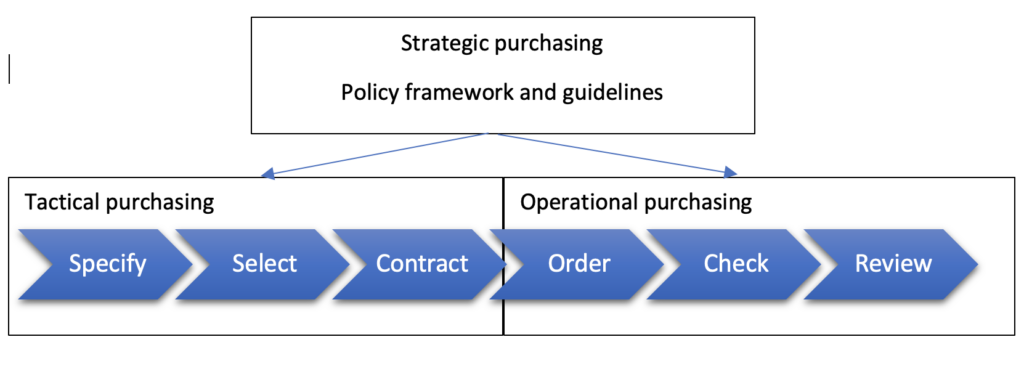Context and relevance
Sustainable procurement starts with sustainable purchasing. This is an opportunity to challenge suppliers to deliver sustainable solutions and for you to select the best. Moreover, it’s your chance to encourage your own employees not to have an order delivered daily or for every single item, but to bundle them. These are just two examples of how procurement can lead to sustainable sourcing. This article discusses these and other options and how campus Heijendaal can get started with sustainable last-mile logistics.
Research question
What are the best ways to adapt the three facilities’ purchasing processes so that the last-mile delivery to Heijendaal Campus becomes more sustainable in terms of the number of transport movements?
Research approach
To answer the research question, we distinguished between options for increasing sustainability at strategic, tactical and operational levels.

Based on a literature review, interviews and graduate research, we determined a number of purchasing options for each level to improve the sustainability of last-mile deliveries to the three institutions. The advantages and disadvantages of the options for each level are presented. We held eight interviews with people at different locations involved in sustainable purchasing initiatives in relation to bundling via a hub. For insights into the organisation of the procurement function at HAN, we reviewed graduate research papers. Finally, the different options were tested with employees of the three institutions in order to make recommendations.
Results
General
At each level, a number of options were formulated to improve campus supply sustainability through purchasing. At a strategic level, the measures are directed towards stimulating the use of the hub. In a hub, shipments by various (diesel) vehicles can be bundled into a single electric vehicle. The result is improved campus sustainability and liveability. Using selection criteria or contract standards in the tender, procurement can stimulate and/or enforce the use of a hub. Procurement measures can also stimulate cooperation with the other campus institutions at this level, limiting the number of suppliers and reducing delivery frequency, resulting in fewer and larger shipments to the hub and campus.
At a tactical level, we reviewed measures that would lead to limiting the number of orders. By placing larger orders, more goods will be delivered at once and the number of transport movements will decrease. This again leads to improved sustainability and liveability to and on the campus. Larger orders can be achieved by reducing the number of suppliers, reducing the share of single orders, or letting the order system collate orders and send them bundled to the supplier.
At an operational level, improving sustainability is about people’s behaviour. Here too, the number of orders has to be limited and potentially longer delivery times (through the use of a hub and the reduction of delivery frequency) will have to be anticipated and accepted. Training and change management so that employees understand how their behaviour impacts sustainability and liveability are essential.
The opportunities are summarised in the table.
Table 1 . Opportunities for sustainable procurement
| Strategic | Tactical | Operational |
| Include delivery to the hub in tender selection criteria. | Reduce number of suppliers | Change employee behaviour: less single orders, accept longer delivery times |
| Incorporate delivery to the hub into the contract (after tendering) | Reduce single orders (designate responsibility for orders) | Training courses and manuals on sustainable behaviour |
| Make purchasing policy and conditions more sustainable (e.g., requirements for delivery frequency and delivery to the hub) | Order system to collate orders | |
| Joint purchasing by the three institutions | Single umbrella system for multiple institutions |
Impact on living lab goals
Sustainability & Quality of Life
By encouraging hub use, reducing the number of orders and delivery frequency, and cooperating with the other campus institutions more sustainability and liveability to and on the campus can be achieved.
Costs
By reducing the number of orders, delivery frequency, and by cooperating with the other campuses, volume discounts can be achieved and transport costs reduced. On the other hand, using the hub will lead to additional costs. The relationship between these two factors has not been investigated.
Service level
Delivery frequency will be reduced due to a number of these measures, and delivery time may increase. Together, this will have a negative impact on the service level.
Conclusions, recommendations and follow-up research
The article describes opportunities for recipients to promote sustainable sourcing during their procurement process. However, to successfully implement the solutions summarised above, it is important to involve other stakeholders:
Improve communication between suppliers and recipients. The proposed hub solution and less frequent deliveries may may challenge (timely) supplier deliveries. Decisions have to be made on what is desired, and to develop realistic SLAs.
We advise hub operators to talk to suppliers and recipients regarding what they can offer and whether a match can be made to accommodate their wishes?
All stakeholders are advised to be open and flexible. Suppliers are challenged through tenders which will lead to new and changed solutions. Stakeholders need to review how these will be workable for all involved. Only through cooperation across the chain will these innovative changes be successful.
